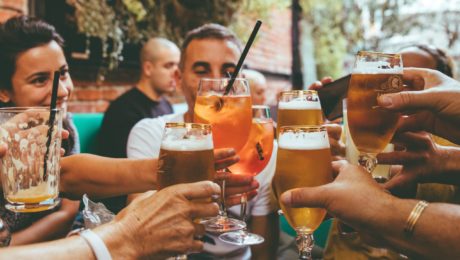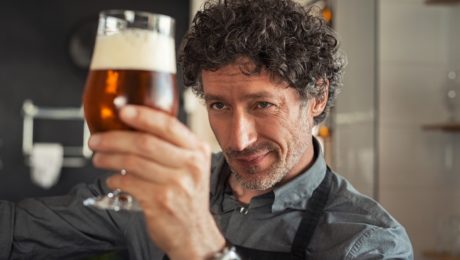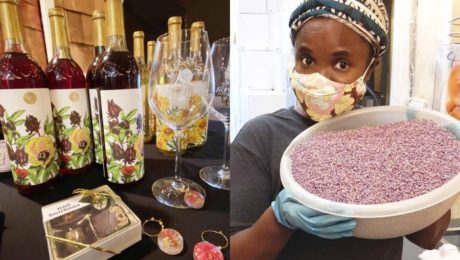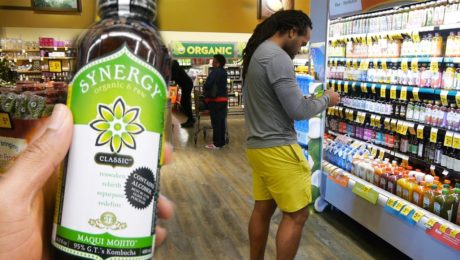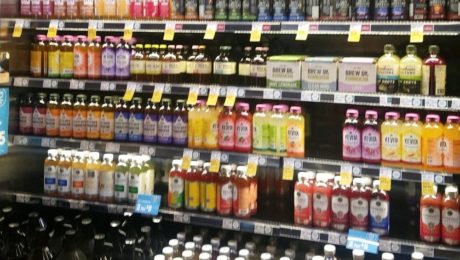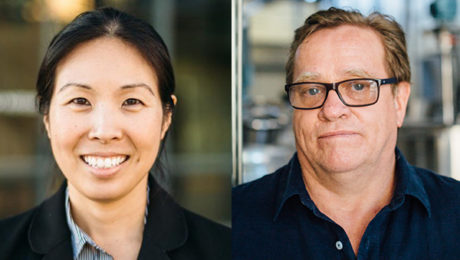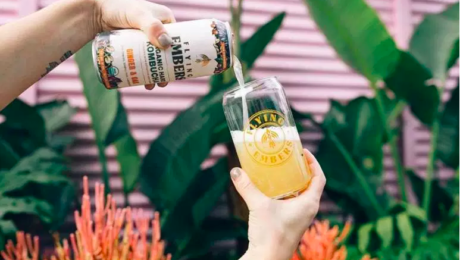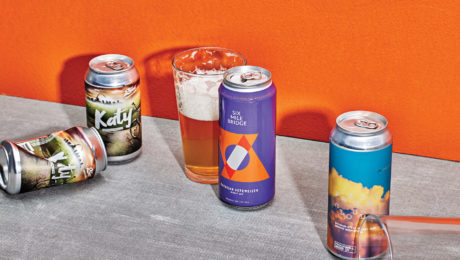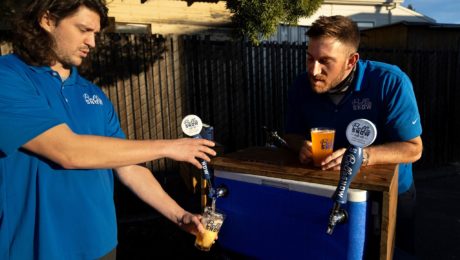Growing the Hard Kombucha Category
Hard kombucha is one of the fastest growing alcohol categories. Could it become the next cider, craft beer or even hard seltzer?
“That’s the big question, isn’t it. It’s up to us to do it,” says Joshua Rood, CEO and managing director of Dr Hops hard kombucha. “If we could make it so good that beer people get excited about it and wine people get excited about it, well now there’s potential for something really, really big. That’s how craft beer did it — they focused so much on quality that they just blew regular beer out of the water on quality and everyone went for it because it was just so much better. We’re committed to what’s possible.”
Declared the “drink of summer” in both 2020 and 2021, hard kombucha continues to grow this year. While still only a small segment (~$58 million) of the overall alcoholic beverage market, hard kombucha’s dollar sales growth is big at 60%. And this performance is at a time when sales are declining for both cider and hard seltzer.
“Seltzer is really homogenous, there’s no differentiation for the most part, whereas kombucha, every brand is very different,” says Joe Carmichael, co-founder of Local Roots Kombucha. “A lot more than craft beer, there’s a lot you can do with it.”
The two spoke on a hard kombucha panel at KombuchaKon, joined byJames Conery, manager of innovation at Sierra Nevada Brewing Co., and Steve Dickman, owner and brewmaster of Rocky Mountain Cultures and High Country Kombucha. The brewers agreed: hard kombucha can become as great as the craft beer category.
“For us, fermentation is part of the process,” Rood says.”There are live lactobacillus cultures still alive up to 11% ABV [Dr Hops ABV]. We chose that [alcohol level] because, for us, it was an expression of craft. It was a great style.”
The acidity of kombucha masks the taste of alcohol, making hard kombucha a smoother, tangier drink. While beer is made from grain, hard kombucha is made from tea leaves. This gives it its “better-for-you” profile, drawing on the antioxidants, vitamins and minerals in tea.
Kombucha brewers hoping to add a hard kombucha line need to realize that it is a “totally different business than non-alcoholic,” Rood says. The regulations are strict.
“If you’ve never done an alcohol booch and you’re going to get into it, some of the things we’re going to touch on, like probiotics or health claims, the TTB (Alcohol and Tobacco Tax and Trade Bureau) has very big issues with health claims,” says Steve. “You cannot make health claims with alcohol. …There are a lot of regulations that come with it, a lot of ingredients you can’t use.”
Adds Conery, who runs the Strainge Beast brand for Sierra Nevada: “If you’re thinking about doing hard kombucha, you really need to research all the regulations before you start to do anything, before you even make it, so you know what you need to do.”
Even brewing hard kombucha is not without its challenges, too. Similar to beer, it requires the monitoring of key parameters — acidity, temperature, yeast strain, nutrients, time. But yeast is a delicate organism that can be difficult to manage, but which can alter the flavors of a brew.
Creating their first non-beer line came with growing pains for Sierra Nevada, one of the largest brewers in the U.S. Strainge Beast’s launch in 2020 required the company to make a substantial investment in its Chico, Calif., brewery, to seal off and isolate its beer operations from the hard kombucha line.
“As a brewer, I’ve spent my entire life making sure what kombucha is does not get into my brewery, because everything in kombucha is what you’d consider a beer spoilage organism,” Conery said. “We have to be very good about keeping what we’re doing with our kombucha segregated. As you scale up — especially with alcohol — there are a lot of things that can go wrong.”
Working with yeast is always a growing experience, “I’m still in the trial and error process,” Conery said. It took Sierra Nevada “quite a long time to find the correct yeast strain when we were fermenting to make our alcohol.” Yeast can create unique flavors — or funky, bad-tasting brews. A brewery will spend months exploring what yeast they want to use.
“It is the most interesting and horrible part of the production side, which is how to get the flavors you want, effectively,” Rood said. “When you’re dealing with a very acidic environment, that’s one of the biggest challenges and you want that acidity, which is part of the challenge. But you want your yeast to do a good, clean, healthy job of fermenting the alcohol.”
While both Sierra Nevada and Dr Hops approached hard kombucha with backgrounds in craft beer, Dickman at High Country Kombucha came from the kombucha world.When making hard kombucha, he brews the kombucha flavor he wants, then creates a neutral seltzer-like base. He blends the two together for the ABV value he desires, and says he likes this method as a way to experiment with acidity profiles.
“Kombucha was always a cool beverage, but now it’s bringing the party,” Dickman said.
- Published in Food & Flavor
South Carolina Classifies Kombucha as Alcoholic
Kombucha can no longer be legally sold as non-alcoholic in the state of South Carolina. A new rule change in state code set a maximum alcohol content for beers and other fermented beverages, but did not set a minimum alcohol level. Any fermented beverage with an alcohol content above 0.0% — any trace of alcohol — is now considered alcoholic by default.
Last month, TFA wrote about a decades-old South Carolina law that threatened kombucha and non-alcoholic beverage producers selling their fermented drinks in the state. Kombucha, which typically contains less than 0.5% alcohol [the legal definition of an alcoholic beverage in the U.S.], has always been deemed non-alcoholic, sold on grocery store shelves next to refrigerated juices.
Now, any brand selling a fermented beverage in the state must apply for an alcohol license, and their drink cannot be sold to anyone under the age of 21.
“Effective immediately, all of these producers and retailers will have to cease business until they receive the proper licensing, which will take several months to get if they’re located in South Carolina and the money to get their facilities up to code,” said Brook Bristow, an attorney specializing in beverage law, in a statement about the rule change. “So, until then, no sales, i.e., no money.”
Adds Gabriel Coggins, owner of the S.C.-based Kava Konnection:“Of all the things lawmakers could focus on to restrict and take away from the public, kombucha was the last thing I expected. It’s a healthy product, and the only logical reason I can see beyond some strange maliciousness toward it is that they just didn’t understand what they were doing.”
Read more (Greenville Journal)
- Published in Business
Tastier Non-Alcoholic Beer
Though non-alcoholic drinks are growing in popularity, alcohol-free beer has been a laggard. These brews lack the flavorful aroma of hops, with the resulting beverage flat and watery.
Mimicking beer’s flavor profile has been challenging for brewers hoping to appeal to dry drinkers. Some producers add aroma hops in the final stages of brewing, but it’s expensive and wasteful.
“When you remove the alcohol from the beer, for example by heating it up, you also kill the aroma that comes from hops. Other methods for making alcohol-free beer by minimizing fermentation also lead to poor aroma because alcohol is needed for hops to pass their unique flavor to the beer,” says Sotirios Kampranis, a professor in University of Copenhagen’s department of plant and environmental sciences who led the research.
Now researchers from the university have found a possible solution. Their innovation uses baker’s yeast that’s grown in fermenters and releases an aroma of hops. Results of their study were published in the journal Nature.
“After years of research, we have found a way to produce a group of small molecules called monoterpenoids, which provide the hoppy-flavor, and then add them to the beer at the end of the brewing process to give it back its lost flavor. No one has been able to do this before, so it’s a game changer for non-alcoholic beer,” Kamprani says. “When the hop aroma molecules are released from yeast, we collect them and put them into the beer, giving back the taste of regular beer that so many of us know and love. It actually makes the use of aroma hops in brewing redundant, because we only need the molecules passing on the scent and flavor and not the actual hops,” explains Kampranis.
Sustainable Solution
Their discovery represents a potential breakthrough for the overall beer industry because, researchers point out, it could improve beer’s sustainability.
Aroma hops require an enormous amount of water. Over 713 gallons are needed to grow one kilogram of hops. And sourcing fresh hops involves a carbon-heavy supply chain. Hops are farmed mainly on the U.S. West Coast, so trucks and refrigeration units are needed for transportation .
By using baker’s yeast, researchers can create a hoppy flavor without wasting gallons of water and creating carbon emissions.
“With our method, we skip aroma hops altogether and thereby also the water and the transportation. This means that one kilogram of hops aroma can be produced with more than 10.000 times less water and more than 100 times less CO2,” Kampranis says. “Long term, we hope to change the brewing industry with our method – also the production of regular beer, where the use of aroma hops is also very wasteful.”
Kampranis and colleague Simon Dusséaux plan to have the process ready for the brewing industry by this October. The two have founded the biotech company EvodiaBio.
- Published in Food & Flavor, Science
An Overlooked Wine Category
“Aaliyah Nitoto, winemaker at Free Range Flower Winery, is tired of hearing that the category of wine is exclusive to grapes. For centuries, wine has been made from many kinds of plant products, she says, like grapes, apples, pears, rice and flowers,” reads an article in Wine Enthusiast.
The magazine highlights the history of flower wine, which has variations in the Middle East, Asia, Europe and even the U.S. The process to make the wine is different from a traditional grape wine. Fresh or dried flowers are boiled and crushed, then yeast and a sugar source are added to start the fermentation process.
Flower winemakers lament that their product is not respected in the wine industry. Flower wine has been made primarily by middle- to lower-income women.
“That can tell you right there why they were relegated to obscurity. The people who owned tracts of lands that had money and influence and got to name things like ‘noble grapes,’ they got to say what was wine and what wasn’t,” Nitoto (pictured) adds. “The opinion of people in this country over the last 100-odd years to try to get rid of this category doesn’t stand up to the history of winemaking, which is thousands of years old, which does call this wine.”
Read more (Wine Enthusiast)
- Published in Food & Flavor
Kombucha Sales Crawl
Two years after kombucha sales began to clock double-digit growth during the pandemic, sales are slowing, increasing only 1% over the last 52 weeks. But kombucha is still the sales leader in the fermented, non-alcoholic beverage space, representing nearly 85% of the category.
Kombucha pioneered the refrigerated functional beverage industry. For years it was one of the few beverages in the fermented, non-alcohol beverage space. But now there’s competition from new functional drinks — like prebiotic- and probiotic-infused sodas — that are diverting sales from kombucha.
“The consumer really is not OK with just drinking water. They want functionality out of everything they consume,” says Caroline Davidson, director of channel partnerships at SPINS (a data provider for natural, organic and specialty products). “Non-alcoholic beverages are traditionally not healthy options. To see that kombucha is actually one of the few segments contributing to double-digit growth (in that category), it’s really refreshing and encouraging.”
Those numbers were presented at KombuchaKon, the conference and trade show produced by Kombucha Brewers International (KBI). The event had been virtual the last two years, and brewers were anxious to meet in person again. Hundreds of brewers and brand leaders converged last week in Long Beach, Calif.
Here are highlights from SPINS’s kombucha market analysis.
Functional Beverages Grow
Refrigerated functional beverages are a top growth category across all sales channels — natural products stores, regional groceries and multi-outlet retailers (MULO) like WalMart, Target and CVS. Beverages made with -biotic cultures, high fiber sodas, water kefir sodas, drinking vinegars, kvass and tepache are all part of that growing category — and they compete with kombucha.
Shelf-stable functional beverages are growing even more quickly. For example, in the natural channel, sales of these drinks have increased nearly 25%, versus 4% for their refrigerated counterparts.
“It may not be refrigerated, but it still may be competition to a kombucha,” Davidson says.
Major Brands Diversify
Kombucha-adjacent products — like powdered kombucha and kombucha-flavored yogurt bites — are entering the market. So are kombuchas with no sugar or less than 1 gram of sugar.
“I am consistently seeing no sugar options in fermented beverages, which I know I’m speaking to an audience that already knows this, but fermentation doesn’t happen without sugar,” Davidson says. She notes more and more beverage categories “are seeing differentiation within probiotics of fermentation.”
Of the five fastest growing kombucha brands,— only two – Wild Tonic and Better Booch – are selling just traditional kombucha or hard kombucha. The other three – Humm, Health-Ade and Rowdy Mermaid – have added new product lines. Humm and Health-Ade sell prebiotic sodas and Rowdy Mermaid offers tonics.
Health-Ade is marketing their brand as a “gut health beverage” instead of simply kombucha. In a statement, Health-Ade CEO and co-founder Diana Trout says: “We have seen a dramatic increase in consumer interest in gut health over the past year as people begin to realize just how important gut health is to immunity and overall health. We wanted to offer our customers something that doesn’t compromise on taste and has legitimate gut health benefits, and (our new prebiotic drink) Pop does just that.”
Defining the Product
KBI has been well aware of changes in the category. Two years ago, it released the kombucha Code of Practice, the first set of safety and quality standards for the industry.
“Kombucha” is not a protected product name, unlike “tequila” or “champagne.” With the code, KBI aims to protect kombucha as a traditional fermented beverage. But KBI also doesn’t want to eliminate kombucha brands that may pasteurize and sell in shelf-stable cans, process from a base or brew with sweeteners.
Joshua Rood, CEO and managing director of Dr Hops hard kombucha, attended the SPINS presentation and thinks KBI “is standing in the right place.”
“First, we have to define what kombucha is. And then how you label variations of that, like if it’s filtered or pasteurized. Then you can actually have clarity and transparency for consumers so they actually know what they’re getting,” Rood says. “Right now, we don’t have that. It’s very rough, it’s essentially just an honor system.”
Rood emphasizes he has no problem with kombucha brands not brewing with traditional methods. But he says there needs to be a classification system and transparent labeling of how a kombucha is made. “There’s a lot of room for education,” he says.
Dr Hops, for example, prints a nutrition fact panel and calorie listing on their hard kombucha, even though most beer, wine and spirits are not legally required to do so.
“We try to be massively over-communicative on our labels,” Rood says. “And, if you’re looking at our labels from a calorie stance, it doesn’t look good because we have such high alcohol content. We’re not competitive in calories. But if we put it on there, people will learn that it’s 10% alcohol and most of the calories come from the alcohol.”
Shift in Retail Channels
Sales in natural stores – the retail channel that helped launch the kombucha industry have slowed, actually declining 5% over the past year. . But sales over the same period grew 3% in MULO outlets and 2% at convenience stores.
“People are still trying to find outlets where they can get everything in one trip,” Davidson says. “We’re seeing a lot more consolidation of what people are purchasing in one trip or fewer trips per month.”
Hard Kombucha “Massively Outperforming”
SPINS’s “flavored malt beverages” category includes a number of alcoholic drinks that don’t contain malt. While hard seltzers have long dominated here, six of the 10 fastest-growing brands in natural retailers are now hard kombucha brands: Boochcraft, Flying Embers, June Shine, Kyla, Strange Beast and Nova Easy.
“Natural retailers are fully embracing this as a new category and it’s paying off exponentially,” Davidson says.
Hard kombucha sales are still small overall, at $58.31 million, are driving growth in the category and “massively outperforming hard cider,” Davidson says. Dollar growth for hard kombucha is almost 60%, while sales of hard cider are declining. Sales for the hard seltzer – including category leaders White Claw and Truly – are also slipping in all retail channels.
- Published in Business
Could Outdated Law Force Fermented Drinks Off Shelves?
A decades-old South Carolina law is threatening kombucha and non-alcoholic beverage producers who sell their fermented drinks in the state.
The current statute dictates that a permit is needed to sell beer and other fermented beverages. But the law lists no minimum ABV, forcing kombucha brewers and non-alcoholic beer producers to follow the same permitting regulations as alcoholic brands.
Though the statute is loosely enforced, it came to a head recently (pun intended). Non-alcohol beer company Athletic Brewing Co. announced it would no longer sell their products in South Carolina due to ““the recent legal interpretation by state officials on the unique definition of non-alcoholic beer.” The state’s Department of Revenue began investigating Athletic Brewing Co. after receiving a complaint about the brewer.
“This is definitely going to create a lot of uncertainty for a lot of different types of businesses and, you know, ultimately, the question is, ‘Are we going to apply the alcohol rules to companies who don’t necessarily, you know, the alcohol is so minimal?’” said Brook Bristow, an attorney at Bristow Beverage Law, who served as Executive Director of the state’s Brewers Guild for seven years.
Brewers that want to comply with the current law have to apply for an expensive license. SouthCarolina’s General Assembly currently has no bills under discussion that would modify the regulations.
Read more (The Free Times)
- Published in Business
Upcycling Olive Oil, Wine & Beer Byproducts
The olive oil, wine and beer industries each create an enormous amount of waste. Producers, vintners, and brewers dispose of millions of tons of pomace and spent grains every year, often at a big cost.
To a crowd of food industry professionals at Natural Products Expo West, professors at University of California, Davis, shared their research into how these byproducts can be upcycled.
“There’s a lot of waste that can be generated doing agriculture and food processing,” said Selina Wang, PhD, Cooperative Extension Specialist in the Food, Science and Technology department. Globally, good waste is estimated at 140 billion tons a year. “That is a lot, but also a lot of opportunities for us to explore.”
Olive Oil Waste
Wang, who researches small-scale fruit and vegetable processing, says olive oil needs a byproduct solution. Oil is only 20% of an olive’s weight – the other 80% is discarded in olive oil production. Globally, the industry generates 20-30 million tons of olive pomace a year.
What industry, Wang questions, would operate using only 20% of their commodity?
“This is an industry that has been made to use the minor product. But we know there’s a lot of values in the byproduct,” Wang says. Olive pomace has numerous active health compounds which, when consumed, are proven to prevent disease like cancer, Type 2 diabetes and cardiovascular disease. But disposing of this byproduct creates a large carbon footprint. “Can we have a solution to climate change while at the same time improving our health?”
Many producers use the waste as animal feed, giving it away to ranchers. But often, the cost of transportation is too high to justify the benefits. And using olive pomace for compost is not ideal, as it has a negative effect on soil microbes.
In a recent UC Davis study, olive pomace was added to pasta, bread and granola bars, which were then tested for consumer acceptance. Tastes were strong and the grains turned purple when the pomace was added, so the amount of pomace added was low (7% in the pasta and 5% in the bread and granola bars). Consumers didn’t hate the products – they liked them slightly less than the unfortified versions – but the majority said they wouldn’t pay more for the items made with olive pomace.
“I would challenge us to think outside the status quo,” Wang says. “Olive oil was an industry developed with tradition, love and passion. But does it make sense to have an industry where we’re using only 20% of raw material? Or do we actually have an industry focusing on the 80% and the 20% is a wonderful gift we give to family and friends?”
Grape Waste
Further UC Davis studies are also looking at wine byproducts The global wine industry produces 10-13 million tons of grape pomace annually.
That waste is rich in flavonoids and oligosaccharides. UC Davis and Iowa State are currently studying the flavonoids as natural antioxidants and the oligosaccharides as prebiotics, and if they would have a synergetic effect on gut health.
“It basically shows there’s a second life to winemaking and the wine byproduct that’s generated,” she said.
Researchers at UC Davis who have studied feeding cows seaweed to reduce greenhouse gas emissions have proposed to the California Research Dairy Foundation that they use grape pomace instead. It’s cheaper than seaweed and cows burp less after consuming grapes.
Other industries, such as cosmetics, pet food and construction, could also use the byproducts. For example, a new study shows how construction companies could use olive pomace in asphalt paving and building materials.
Brewing Waste
Waste streams are an even bigger problem for the brewing industry, says Glen Fox, PhD, the Anheuser-Busch endowed professor of Malting and Brewing Science at UC Davis. Brewers globally produce over 49 million tons of spent grain a year.
That waste is high in water content (about 80%), but most brewers don’t have the ability to store wet grain. Similar to olive and grape pomace, it’s cheap feed for animals. But the cost of transporting spent grain outweighs the benefits for most breweries.
“At the moment, they’re giving it away,” he says. “They would like to get something back for it.”
Fox sees big opportunities for food producers to use brewing grains, which are packed with nutrients. Compounds can be extracted, such as dietary fiber for supplements, hydrocinnamic acid for makeup and even cellulose pulp for toilet paper. Fox is working on a patent for a process that would allow grains to be applied directly to soil.
The craft brewing industry is “the most viral business in America,” Fox said. There are breweries everywhere – some 9,000 craft brewers in the U.S., with over 1,000 in California alone. But there are not nearly as many food production facilities that can collect the spent grains.
“This industry is in an advantageous position because it has that waste stream every day,” Fox says. “If you want to potentially use this in your business, you don’t have to look far for your supplier.”
When Will the Food Industry Innovate?
“We have to start rethinking our food systems – farm to mouth,” Fox said. “It’s a big challenge.”
There’s no shortage of high-quality research on options for olive oil, wine and beer byproducts, Wang points out. The food industry needs to innovate profitable, desirable products made from upcycled ingredients. At one point whey – a byproduct of cheese production – was dumped down the drain, Wang said. Now it’s a popular protein supplement, in powders and bars.
Two brands are making inroads. Vine to Bar uses grape pomace to make chocolate. ReGrained uses spent beer grains to make pastas, bars and puffs.
“The key is we need to go from a linear economy – which is just made to waste – to a circular economy where we can avoid generating these wastes by upcycling every waste or every byproduct that we generate,” Wang said.
Consumer Sues Hard Kombucha Brand
Fermented Sciences, maker of Flying Embers hard kombucha, is asking a judge to dismiss a class action lawsuit against the brand. The suit alleges the health benefits of Fermented Sciences’ kombucha and seltzers are misleading.
The complaint says it’s confusing the label lists “vitamin C,” “antioxidants,” “real botanicals” and “live probiotics” because the drink is alcoholic and the USDA Dietary Guidelines advise that “alcoholic beverages are not a component of the USDA Dietary Patterns.” Consumers, plaintiff Katie Kuciver says, may believe Flying Embers’ positive ingredients outweigh the negative effects of drinking alcohol.
In the 17-page response memorandum, Fermented Sciences argues the plaintiff’s complaints are “bald assertions” and the consumer’s belief that the implied health benefits on the hard kombucha label could counteract alcohol are “implausible.” The Flying Embers label, Fermented Sciences points out, includes a surgeon general’s warning about the adverse health issues of drinking alcohol.
“Reasonable consumers would understand that the products are alcoholic beverages that may cause health problems, but that defendant’s products also include juices with antioxidants as well as probiotics. There is no deception,” Fermented Sciences writes in their response.
Read more (Law360)
- Published in Business
Experimenting with Yeast
The craft brewery industry is seeing increased innovation — and beer drinkers eagerly embrace these novel experiments. Brewers are turning to new, unique yeast profiles for distinctive drink styles.
“Whether a brewer chooses to ferment hot and quick or slow and cold is in large part a direct response to what microorganisms – i.e., yeasts – they select to turn their sugar water (aka wort, in beer-speak) into beer; and depending on the temperature and amount of yeast used, the same yeast profile can yield different flavors. Will a yeast profile influence the drinker’s experience?” reads an article in Sauce magazine. “The past several years have seen substantial innovation in the fermentation process leading to greater efficiency and efficacy.”
Yeast isolates used more and more by craft brewers include the lager-style Lutra kveik (kveik being the word for yeast in Norwegian). Kveik strains produce fruity, tropical-tasting beers. Another yeast rising in popularity among brewers is Sourvisiae, which produces a more sour flavor.
Read more (Sauce)
- Published in Food & Flavor
“More Brew, Less Buzz”
The craft beer industry has been dominated by strong brews or alcohol-free varieties. The New York Times highlights how “craft brewers are increasingly aiming for the sweet spot in the middle.” Low-alcohol beers are growing in popularity, appealing to consumers who want moderation not abstinence.
“There’s just this completely unexplored space,” says Sean Boisson. He started Bella Snow Soft Ale in California, which focuses on ales with no more than 2.4 percent ABV (about half the strength of a traditional beer). Christophe Gagné, owner and brewmaster of Jack’s Abby Craft Lagers in Massachusetts, created a series of low-alcohol beers he calls the 2% Beer Initiative, which has become a bestseller. “I would much rather have two beers and not fall over,” he adds.
The trend is reflecting the preferences of older beer drinkers. Their bodies can’t handle the aftereffects of alcohol and they want to ease back into their IRL responsibilities without a hangover.
“We’re not surprised that lower-ABV. beers are coming of age because, well, millennials are coming of age,” said Lester Jones, the chief economist for the National Beer Wholesalers Association.
Brewers note low-alcohol beer is a challenge. A beer with less alcohol is not easier or even cheaper to produce. Low-ABV beers require less malt (the grains supplying the sugars that are fermented into alcohol) but, if hops are too plentiful, the flavor becomes bitter. And a quality low-alcohol beer also can’t be watery.
Read more (The New York Times)
- Published in Food & Flavor

